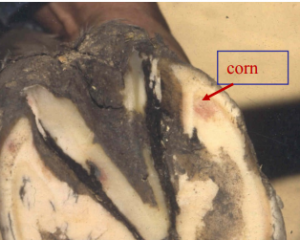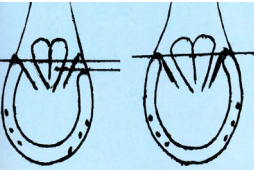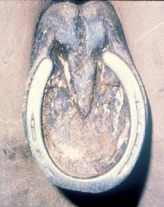Equine podiatry
Solar bruising & corns
Dr. F Tóth notes
Definitions
Solar bruising : Contusion caused by impact – results in hemorrhage of the solar corium.
Corn: solar bruising located in the medial angle of the sole

Etiology
Bruising is typically caused by:
- Shoe that is too small or does not extend far enough back under heels (this causes corns)
- Long-toe/low-heel conformation (toe-bruising as horse tends to land on toe)
- Flat and/or thin-soled feet
- Riding on hard or rocky ground
- Foot that has overgrown its shoe- shoe rides on sole

shoe does not extend far enough back 
shoe is too small
Clinical signs and diagnostic tests
Lameness varies. It can be acute and severe or chronic and mild. Bruising often affects several feet. If both front feet are affected, it can resemble laminitis. Lameness may worsen when the shoe is removed due to the increased pressure on the bruise by rocks and dirt.
Increased digital pulses are often present. Discoloration of the sole (bruise) may be evident on unpigmented feet or if the bruise is deep. The horse will typically be positive on hoof tester examination in the bruised area.
Lameness should improve after palmar digital nerve anesthesia.
Treatment
- Phenylbutazone or other NSAIDs
- Eliminate shoeing problems (replace a small shoe, etc)
- Apply caustic agent to toughen sole, such as iodine, formalin, or phenol (i.e., sole paint)
- Apply a pad until the sole can toughen
- Apply a wide-web shoe to support the foot
Key Takeaways
Corns are sole bruises at the medial angle of the sole.
- These are usually due to a poor fitting shoe (too long between resets).
- Bilateral lesions are common
- Treat with NSAIDs, hoof tougheners and better fitting shoes
Resources
Remedial shoes – Horse and Hound
Other Clinical Problems of the Equine Foot Vet Clin Equine 37 (2021) 695–721

